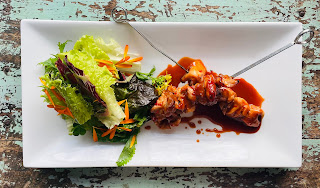There’s been a well-documented rise in the food to go and meal kit area and considerable innovation as the restaurant sector struggled to pivot. Food truck numbers increased exponentially and these days it’s more usual to see a coffee machine in a horse box than a horse…
On the other end of the scale, Forbes predicts a rise in cooking robots and automation in the dining industry fuelled by labour shortages.
Expect to see more food ATMs and vending machines. Meanwhile, anyone living in a city or big town can’t have failed to notice the stratospheric rise in delivery bikes – akin to London or LA. After an initial rise in home cooking, cooking fatigue appears to have set in.
Nonetheless, my new book, How to Cook - 100 essential recipes everyone should know, is getting a tremendous response from people who think they can’t cook but would love to…! I’m always happy to write a personal message on request…
There’s a definite rise in the number of people prioritising food and drink products that promise additional health and well-being benefits. It’s difficult to get up-to-date figures on the number of vegans and vegetarians in Ireland but the increasing number of menu options and products on supermarket shelves acknowledges the growth in these areas. Plant-based ‘meats’ like the Impossible Burger and Moving Mountains Burger that sizzle and bleed continue to gain fans.
This year, reductarianism is the new buzz word. It has been dubbed one of the top 10 trends: Reductarians are “Not ready to go full vegan but want to significantly reduce consumption of meat”. This group are determined to make more sustainable life choices and restore the ecosystem. They seek out high quality pasture fed meat produced to high-welfare standards and want to be reassured of environmentally friendly production methods. The plant-based sector and the number of ‘plant-curious’ eaters is growing exponentially. The growing number of environmentally aware consumers want to hear that farmers are making an increased effort to protect wildlife and restore ecosystems.
According to Waitrose, nearly 70% of shoppers are going the extra mile to reduce their carbon footprint in some way or another. Research confirms that environmental awareness amongst consumers has surged during the past year with 85% of us making more sustainable life choices.
Trend forecasters have also noted that those working from home are eating bigger and enjoying more experimental breakfasts.
There’s been a spike in the sale of eggs, bacon and demand for all manner of exotic mushrooms is way up. Kits to cultivate oyster and lion mane mushrooms at home are all the rage. Post cereal snack packs to munch during the day and frozen sandwiches are emerging as lunch solutions.
Pet food sales have gone through the roof.
Urban hydroponic farming is a huge trend in cities all over the world. Everything from salad greens to exotic mushrooms. Innovation in indoor farming and growing some of our own food has skyrocketed. Some vegetable seeds were in short supply last year so order early for 2022. Supermarkets are using roof space to grow both indoors and outdoors. Hydroponics is creating a new interpretation of locally grown – hyper local…Millennials and generation-Z-ers are dabbling with ‘drysolation’.
Buzz less spirits, bottled cocktails and ready to drink cans are revolutionising the bar experience. Definitely one of the top trends and here to stay. Functional fizz infused with probiotics and botanicals to boost immunity and benefit gut health and heart health are all the rage. Water kefir, kombucha, tinctures are mainstream. It’s no surprise that turmeric, with its many health-giving properties, is popping up everywhere, not just in fermented foods. Sauerkraut, kimchi and pickles continue to gain market share. Our love affair with coffee continues unabated. Cold coffee is trending. Look out for Amazake-Japanese coffee, Vietnamese iced coffee. Plant based dairy sales are up. Potato milk is the next big thing, it will be in a coffee shop near you before too long.
Japanese, Korean and Chinese flavours are trending. Sales of umami paste are gathering momentum. Food of the Caucasus and the Levant are also on foodie’s radar. Spicy foods are here to stay from Indian garam masala to Mexican tajini (a mixture of dehydrated dried chillies, lime juice and sea salt), Indonesian sambal oleck, BBQ rubs, Japanese gochujang – all add a pop of flavour.
Pomegranate molasses, Turkish urfa, chilli flakes and feta are flying off shelves. Every list includes Yuzu, the sour tart tangerine sized citrus from Japan, Korea and China that’s taking the culinary world by storm. Use it in drinks, cocktails, vinaigrettes, mayo, ponzu sauce, desserts… mostly available so far as a juice or a bottled sauce. There’s also a craving for old-fashioned flavours that bring back memories of happier more carefree times.
CBD food products, both food and drink are moving mainstream. Hibiscus, the red flowers of a colourful shrub, has been dried and used in tea and drinks around the world from Mexico to South Africa for years but are now included in a myriad of foods, ice-cream, cakes – high in vitamin C. Hibiscus tea is the new matcha.
Moringa from the drumstick tree is being hailed as a new super food and tastes a bit like dried cherries.
 Artisan bakers are burgeoning, virtually every small town in Ireland will soon have an artisan bakery and a range of viennoiseries offering natural sourdough. Market leaders are liaising directly with farmers to grow heritage grain varieties and using freshly milled flour for their loaves.
Artisan bakers are burgeoning, virtually every small town in Ireland will soon have an artisan bakery and a range of viennoiseries offering natural sourdough. Market leaders are liaising directly with farmers to grow heritage grain varieties and using freshly milled flour for their loaves.Sales of herbs and spices are up over 40% since 2020.
By no means a comprehensive list, and it’s always interesting to keep an eye on what is trending in the US. It’ll be coming our way before too long. There’s more genuine concern about food waste. Labelling is becoming more ‘homey’ with terms like 100% grown on American soil and regionally grown produce – watch that space...
Happy New Year to all my readers. Do continue to buy seasonal produce. We can all make a difference to local farmers and food producers with how we choose to spend our food money.






